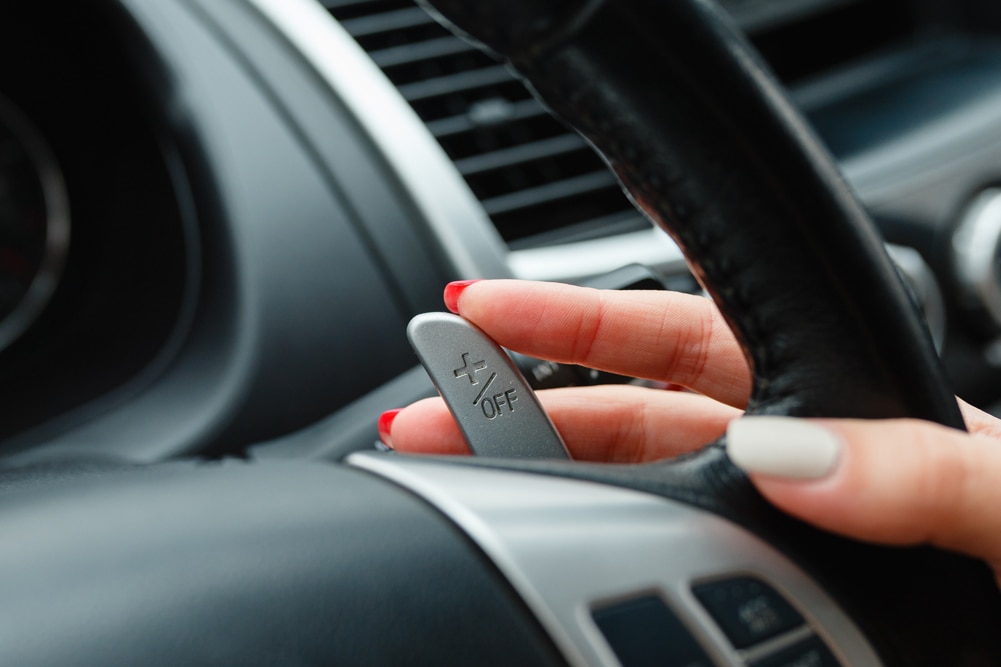When to Use Paddle Shifters
Those little levers behind the steering wheel aren’t there for decoration. This is why they exist and when to use them.
 Shutterstock
Shutterstock
Many modern cars, trucks, and SUVs with automatic transmissions come equipped with paddle shifters affixed to the steering column or the back of the steering wheel that allow the driver to manually command upshifts or downshifts. This may seem superfluous to most drivers. After all, the idea of an automatic transmission is that it picks the right gear at any given moment based on the vehicle’s speed and the driver’s accelerator-pedal inputs.
That’s the theory, but in reality, there are specialized situations, when you may be better off proactively changing gears with paddle shifters rather than waiting for the transmission’s computer to react. We’ll cover those scenarios momentarily, but first some basics:
How Do You Use Paddle Shifters?
It’s pretty simple: Pulling the right paddle will upshift to a higher gear. Flicking the left paddle downshifts the transmission to a lower gear. Beyond that, each manufacturer does things a little differently, so you’ll want to read your vehicle’s owner’s manual if you intend to use the paddle shifters extensively.
Depending on the vehicle, when you initiate manual control by pulling a paddle, it may only temporarily override the transmission computer. After a given amount of time (often less than a minute), the transmission will resume shifting for itself. If you want the gearbox to remain in a manual-shifting mode indefinitely, you may have to slide the gear selector out of ‘Drive’ and into the dedicated gate, which is typically labeled with an ‘M’ for ‘Manual,’ an ‘S’ for ‘Sport,’ or a +/-. To resume automatic operation, you either return the gear selector to ‘Drive’ or hold the right paddle for several seconds. The good thing about paddle shifters is that they are programmed to be foolproof. They won’t allow you to shift into a gear that would damage the engine or cause it to stall.
How to Use Paddle Shifters for Performance Driving
In typical cruising, your vehicle’s automatic transmission is programmed to operate in the highest gear possible to keep engine revs low and thus minimize fuel consumption. While good for your wallet, it’s not ideal for performance because your engine makes its maximum power in the mid- to upper-rpm range.
During spirited driving, then, using paddle shifters can really amp up the fun. This is why you often find them in modern performance cars from Audi, BMW, Chevrolet, Dodge, Ferrari, Ford, Lamborghini, Porsche, and others. Before entering a curve, initiating a passing maneuver, or preparing for some other planned acceleration, the driver can tap a paddle to take control of the transmission, downshifting to put the engine into its prime power band. Unlike console-mounted shifters, paddles allow the driver to make gear changes manually while keeping both hands on the wheel. Be advised, though, that by selecting a lower-than-optimal gear, the driver is forcing the engine to rev higher, which requires more fuel.
How to Use Paddle Shifters for Towing and Driving Downhill
The driver can also use paddle shifters to slow or control the speed of the vehicle when it’s traveling down a steep grade. In such a situation, gravity accelerates your vehicle, and while you could use your brakes to slow the car, doing so for an extended amount of time—known as riding the brakes—creates excess heat and wear that can result in brake failure.
Instead, give the left paddle a few clicks to downshift into a gear that maintains your desired speed. You’ll notice an increase in engine rpm and noise, but don’t worry, you’re not damaging anything. You’re merely using the engine and transmission instead of your brakes to moderate your vehicle’s speed.
Paddles come in handy while towing, as you can manually downshift to help slow your load, again saving your brakes from overexertion. And if you know you’re going to need power for acceleration, say, to merge onto the highway or climb a steep hill, you can use the paddles to drop a gear and put the engine in a higher rpm range. Most modern tow/haul modes are good at reacting to road changes by selecting the proper gear, but they can’t anticipate what’s coming up on the road. You, however, can.
Whether you use the paddle shifters to put a smile on your face or safely descend a mountain pass, they’re best put to use by looking ahead and initiating shifts earlier than the transmission would respond.
Written by humans.
Edited by humans.
 Jon Yanca
Jon YancaTo say cars have been a lifelong passion for Jon Yanca would be an understatement. Obsession is probably more fitting. He brings over 15 years of automotive-industry experience spanning from top enthusiast publications, to advertising and marketing, to independent auto repair. When Jon is not writing about cars, you'll find him racing on dirt, pavement, and even ice, or with a wrench in hand maintaining his fleet of vehicles.
Related articles
View more related articles